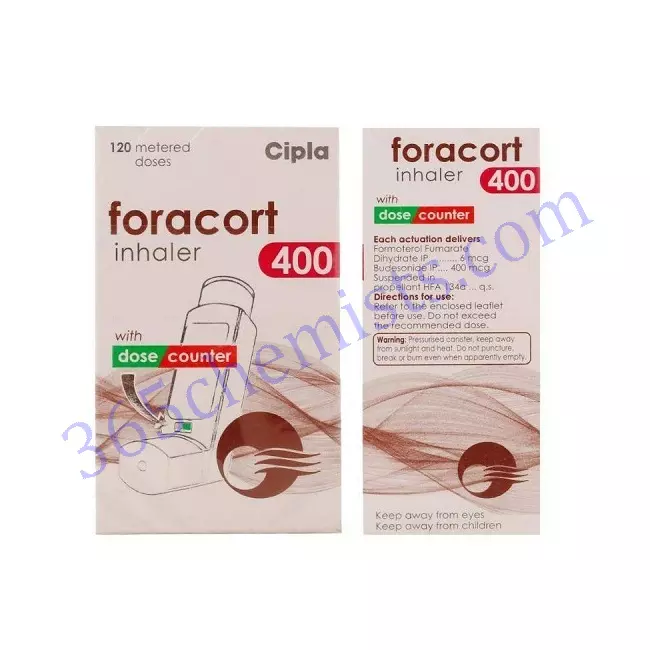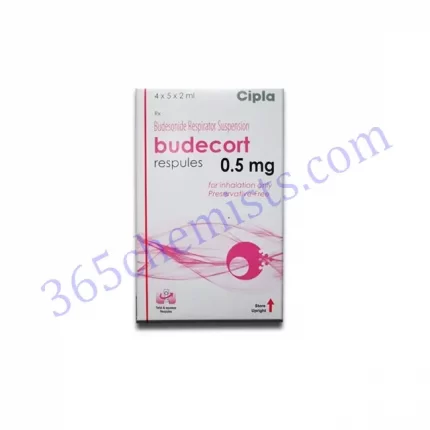Foracort Inhaler (Budesonide 400mcg/Formoterol 6mcg): Effective Asthma Management in a Convenient Inhaler
Foracort Inhaler is a combination medication that is designed to provide comprehensive management of asthma symptoms. It contains the active ingredients budesonide and formoterol, each of which has a different mechanism of action that it performs. The purpose of this detailed description is to provide an overview of the Foracort Inhaler, including a discussion of its therapeutic indications, mode of action, dosage recommendations, potential side effects, and precautions for use.
Therapeutic Indications
The primary use of the Foracort Inhaler is for the treatment of asthma in patients who are 12 years of age or older. It is appropriate for people who have persistent asthma that ranges from mild to moderate severity and who require maintenance therapy. The symptoms of asthma, including wheezing, shortness of breath, coughing, and a tight feeling in the chest, can be effectively controlled and prevented with the help of the Foracort Inhaler. It is essential to keep in mind that the Foracort Inhaler is not designed to provide relief from acute asthma attacks and should not be used in place of a rescue inhaler in such cases.
Mode of Action
A dual-action strategy for the treatment and management of asthma is offered by the Foracort Inhaler, which contains both Budesonide and Formoterol. Budesonide, which is a corticosteroid, functions as an anti-inflammatory agent, thereby lowering the risk of asthma exacerbations and reducing inflammation in the airways. On the other hand, formoterol is a long-acting bronchodilator that relaxes the muscles in the airways. This results in increased airflow and a reduction in bronchospasm. This combination enables patients to achieve optimal control of their asthma and improves their lung function.
Dosage Recommendations
It is possible for the dosage of Foracort Inhaler that is recommended to be different for each individual, depending on the severity of their asthma and how well they respond to treatment. In most cases, the recommended beginning dose consists of two inhalations taken twice daily, approximately 12 hours apart from each other. It is possible to adjust the dosage based on how well an individual is able to control their asthma, with the goal of using the smallest dose that is still effective. It is extremely important to not go above the dosage that was recommended by the healthcare provider and to follow their instructions exactly.
Related Product
Foracort 200 Synchrobreathe Inhaler
Foracort Forte Inhaler
Foracort Forte Rotacaps
Foracort 100 Inhaler
Foracort 200mcg Inhaler
Foracort 400mcg Inhaler
Foracort Respules 0.5 mg
Foracort 1mg Respules
Foracort 100mcg Rotacaps
Foracort 200mcg Rotacaps
Foracort 400 Rotacaps
Potential Side Effects
Even though Foracort 400mcg Inhaler is generally well tolerated, it still has the potential to cause certain adverse effects in certain people. Headaches, irritation of the throat, hoarseness, and oral thrush (an infection caused by a fungus that lives in the mouth) are the adverse reactions that are most frequently reported. These adverse effects are typically mild in nature and short-lived. On the other hand, the Foracort Inhaler has a very small chance of causing more serious adverse events, such as paradoxical bronchospasm (a worsening of breathing difficulties) or allergic reactions. These instances are extremely uncommon. In the event that any serious adverse effects manifest, immediate medical attention needs to be sought.
Precautions for Use
Before beginning treatment with Foracort Inhaler, individuals should inform their healthcare provider about any preexisting medical conditions. These conditions include tuberculosis, infections, and the use of systemic corticosteroid medications. Patients who have a known hypersensitivity to Budesonide, Formoterol, or any other medications containing corticosteroids or LABAs should use the Foracort Inhaler with extreme caution. It is essential to perform routine monitoring of asthma symptoms and lung function in order to achieve the highest possible level of control over the condition.
Foracort Inhaler and Pregnancy/Breastfeeding
There is insufficient information available about the safety of using the Foracort 400mcg Inhaler during pregnancy or while breastfeeding. If you are pregnant or breastfeeding, it is important to discuss the use of the Foracort Inhaler with a qualified medical professional prior to beginning treatment with the medication.
Conclusion
Individuals who suffer from mild to moderate persistent asthma may benefit from using the Foracort Inhaler, which contains both budesonide and formoterol. This inhalation therapy is both effective and convenient. Foracort Inhaler helps control asthma symptoms, reduces the risk of exacerbations, and improves lung function thanks to its combination of anti-inflammatory and bronchodilatory effects. The therapeutic indications, mode of action, dosage recommendations, potential side effects, and precautions that are discussed in this article provide beneficial information for individuals who are thinking about using Foracort Inhaler or who are already using it. However, the best course of action is to seek the personalised advice and direction of a qualified healthcare professional at all times.
Individuals who have the assistance of a trained medical professional can confidently incorporate the use of a Foracort Inhaler into their plan for the management of their asthma. A synergistic effect can be achieved through the combination of budesonide and formoterol, making it possible to more effectively control asthma symptoms and improve lung function.
The Foracort Inhaler provides the benefit of being an inhaler, which makes it simple to administer the medication and ensures that the correct amount is taken. In order to get the best possible results from treatment, it is essential to take the medication exactly as directed by the healthcare provider, both in terms of the dosage and the frequency of administration. It is essential to perform regular monitoring of asthma symptoms and lung function in order to ensure that the treatment continues to be effective and that any necessary adjustments can be made.












